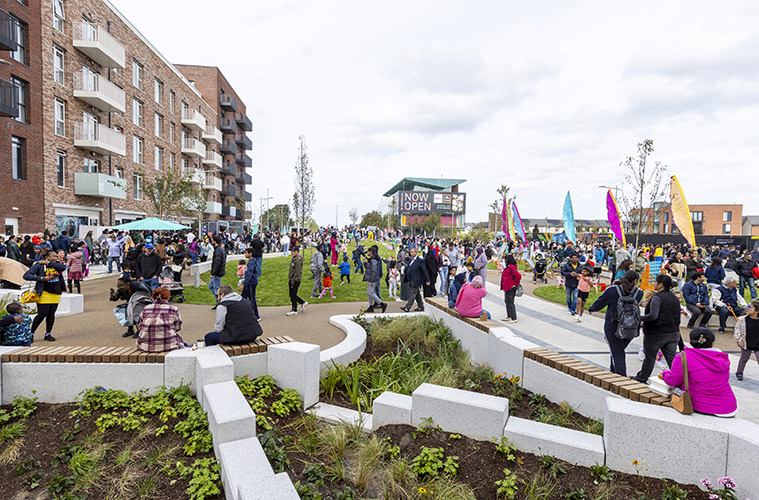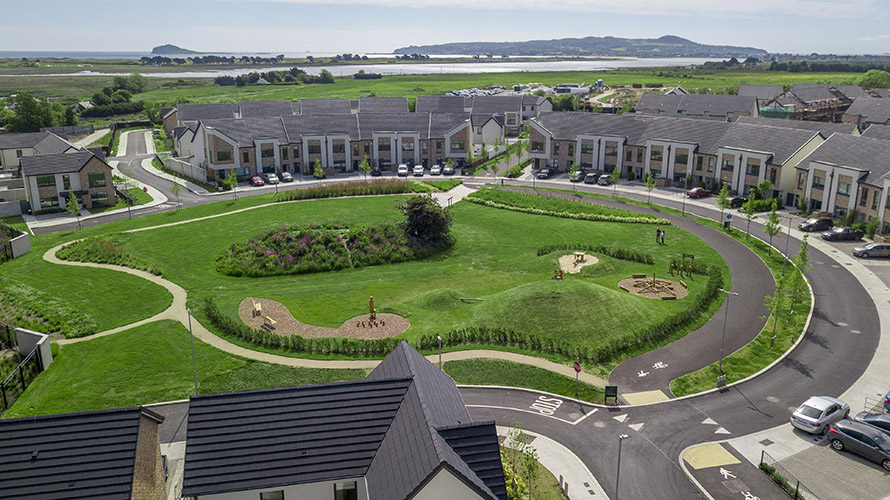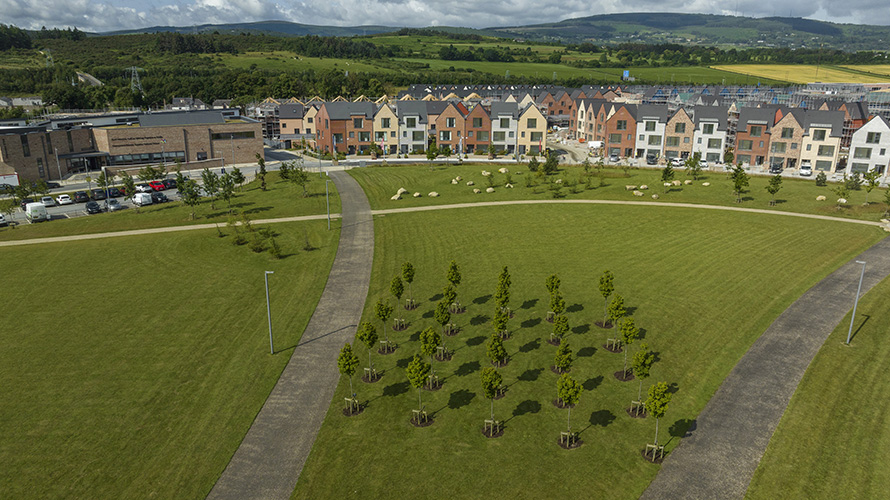Quintain Ireland aims to deliver 1,500 units a year by 2027

MICHAEL HYNES, Chief Executive, Quintain Ireland, speaks with Robbie Cousins about the opening of The Crossings Town Centre in Adamstown, which has been 20 years in the making, and sets out how the company is maintaining its position as Ireland’s third-largest home builder.
About Michael Hynes
Michael Hynes co-founded Quintain Developments Ireland in 2019 and co-led the growth and development of the group since its inception. He is responsible for delivering on the group’s vision to create Ireland’s leading and most sustainable homebuilder. He has worked extensively in property development throughout his career, working on projects ranging from single houses to mixed-use neighbourhoods with more than 5,000 homes. Hynes champions Quintain’s operating culture and values, which are based on customer focus, individual design, and exceptional placemaking with a commitment to delivery for all stakeholders.
As a director of Hudson Advisors, Hynes played a critical role in acquiring these land holdings in Adamstown, Clonburris, Portmarnock, and later, Cherrywood, all of which now fall under the Quintain Ireland umbrella.
Three of the landbanks, Adamstown, Clonburris and Cherrywood, are designated Strategic Development Zones (SDZs), meaning their development is of strategic national economic and social importance. The SDZ designation enables the fast-track delivery of new residential and non-residential development once planning is approved and any contrary provisions in the local authority’s development plan are superseded. The Portmarnock landbank is subject to the local area plan of Fingal County Council.
He has been spearheading the transformation of these sites into what he describes as “15-minute sustainable communities” and modern Irish towns.
A chartered surveyor, Michael Hynes has over two decades of experience in high-level asset management and property development in Ireland. He says Quintain Ireland stands out in the Irish property development landscape because of the sheer scale of its projects.
He explains, “While other developers typically work on numerous smaller sites, we focus on a select number of substantial sites. These are envisioned not merely as developments but as entirely new towns. Their planning prioritises diversity, inclusivity, and resilience, with various housing types and a balanced social mix. We adhere to the principles of the 15-minute community where residents can conveniently accomplish most daily tasks within a 15-minute walk or bike ride from their homes.”
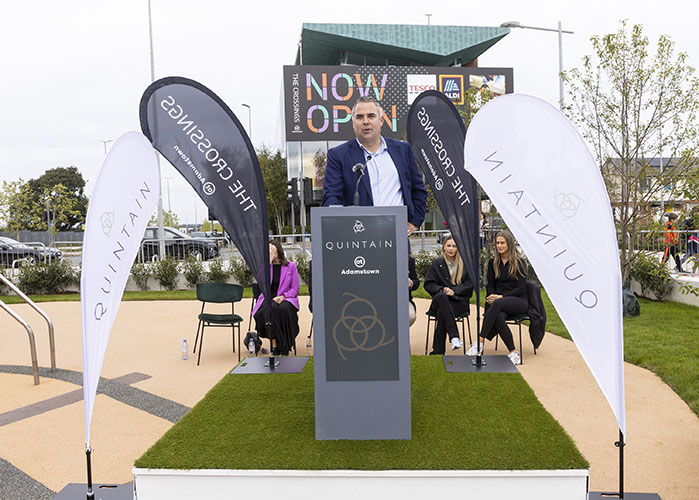
Quintain Ireland performance
Michael Hynes says that Quintain Ireland is performing well and is the third-largest residential developer by sales completions in the country. It is on target to grow its output over the coming years.
“In 2022, we completed and closed 600 units, comprising apartments, houses and duplexes, making us the third largest housebuilder by unit sales completions in 2022. “In 2023, we’re on track to complete around 750 units. So, we’re increasing year on year and maintaining that position as the country’s third-largest housebuilder.
“We currently have four landbanks with the capacity to deliver 8,500 residential units. Unlike some other large housebuilders, we have a small number of large sites rather than a large number of small sites. These sites include a landbank in Portmarnock, which will deliver a further 700 residential units and Cherrywood, with a capacity for 2,700 units. Our largest landbank, in Adamstown, will ultimately deliver 4,700 units. We hope to get our fourth site, in Clonburris, up and running towards the middle or end of next year based on infrastructure delivery.”
The Crossings, Adamstown Town Centre
Adamstown was designated the country’s first SDZ in 2003, and there were very ambitious plans for its development.
Quintain Ireland has just celebrated the official opening of The Crossings urban village centre at Adamstown by housing minister Darragh O’Brien with a huge family day including a funfair, performance artists and food village for the area’s residents. This type of event emphasises the Quintain partners’ commitment to creating sustainable and integrated communities where people can carry out all of their daily activities.
Michael Hynes comments, “Our mission is to create exceptional and affordable places to live, which are at the forefront of design, placemaking and sustainability. This involves the delivery of a high number of homes, but we are acutely aware that we need to build communities too, and, so, we strive to deliver quality amenities and quality open spaces alongside quality housing.”
Quintain is investing €500m in Adamstown, and €200m of this total figure has been invested in The Crossings.
Hynes adds, “The launch of The Crossings is one of the proudest moments in Quintain’s history. Adamstown predates Quintain and has been 20-plus years in the making. The Adamstown SDZ was the first in the country in 2003. The first house was built in 2004, and 1,150 homes by the then-developer followed. Between the downturn in 2007 and 2013, no building took place. Unfortunately, the promised construction of a town centre got caught up in this fallout. But 20 years on, we have now completed The Crossings town centre, which includes 267 apartments, 20 retail units and a two-acre urban park.”
The retail units already have a butcher, pharmacy, bakery, convenience store, hairdresser, and even a veterinary clinic in place.
“Off the plaza, we have an ultra-modern retail building, designed by Henry J Lyons, which houses two large Tesco and Aldi retail units, with a multi-storey car park above them.
“Over 60 per cent of the retail units in The Crossings were leased before completion and are open, being fitted out or about to execute on lease terms, with food and beverage facilities to follow.
The centrepiece of Adamstown Town Centre is the two-acre urban plaza with formal grass areas containing seating and kids’ play areas, including a feature 14-metre children’s train, the largest of its kind in Ireland.
“We think it is a really exciting centrepiece for the town centre and it has been designed and laid out to attract visitors. We don’t just want people to shop there; we want them to use the space to live, relax, work and play.”
He adds, “It has taken 1,000 people working over 20 years to reach this point. These include local authority planners, politicians, design teams, construction workers and financiers. Some, sadly, are no longer with us. Everyone should be proud of the modern space we have created together. On a personal note, I am particularly delighted for the Quintain team, which has also put such hard work into this.”
While the town centre provides the commercial and retail backbone, the two-acre urban plaza park is supplemented by other green spaces. Overall, there are 40 acres of parkland across Adamstown. There are also schools, community centres and sports pitches.
“The town centre is centralised similarly to urban village centres such as Sandymount to ensure people use it and don’t just go there and shop then leave straight away.
“The SDZ was set up on the concept of the 15-minute city. So, living, working, playing, relaxing, wellness, and permeability are all part of the design. Adamstown train station is generally reachable on foot within 20 minutes from anywhere in the town and is a 10-minute cycle, with the town centre being five minutes away by car.”
All homes are nearly zero energy buildings with A1 and A2 BERs and HPI certification. Some of the apartment blocks have BREEAM certification.
Developers Cairn and Tierra are also developing sites within the Adamstown SDZ. “We have gone above and beyond the standard high regulations in Ireland to bring properties and places of the future to life today.
“Since the purchase of the landbank in 2016, 2,950 residential units have been added, and between 10,000 and 12,000 people are now living in Adamstown. While we are about halfway through our delivery plan, nearly all of the infrastructure is in place at a cost of €150m, including the train station, 40 acres of parks, SUDS, pumping stations, substations and all road and cycle networks throughout Adamstown.
“Other than a couple more schools, a library and an enterprise centre yet to be built, we are nearly there on infrastructure. We sold sites to the Department of Education. But there is a backlog in delivering schools. So, they’re a couple of years behind. We plan to complete the rest of the development in the coming four years.”
Challenges
Over the past few months, Quintain has had to address changing market conditions brought about by rising interest rates and increasing costs.
Michael Hynes explains, “The two parts of the business are homes for homeowners, or houses and duplexes, and high-density apartments for investors for state agencies/approved housing bodies n the rental market. There is still massive demand for homes for homeowners. Only last weekend, we had a 46-unit fully-sold launch at our Aderrig scheme in Adamstown. Interest rates are starting to stabilise house price growth, but this also brings cost challenges for us.
“From a demand perspective, houses are still affordable. Wages are increasing with high-paying jobs still being produced, particularly in Dublin.
“Demand remains strong for sub-€500,000 homes. Between €500k and €750k, demand is strong, but price inflation has softened a little. The interest rate hikes generally impact the luxury homes sector first, and while prices are softening here most, there continue to be new high-paying jobs created across Dublin, resulting in this higher price bracket being less impacted than usual in the face of the current increasing interest rate environment.
“From a high-density development perspective, apartments that are built to sell generally aren’t viable because of the values you need to achieve to cover costs and maintain a small margin. Most apartments built these days are for rental because that’s the only viable route.
“Interest rate increases started to pause private institution purchasing towards the end of 2022, and this has been the case across 2023. The institutions want to see price corrections in yields, and rents need to increase to achieve that. It should be noted that the private PRS buyer has essentially paused across Europe.
“However, the difference between Ireland and elsewhere in Europe is that the government is now driving residential construction, whether through LDA with its recent €8bn injection or the €2bn it has allocated to local authorities and affordable housing bodies to deliver social, affordable and cost-rental housing at scale.
“So, while there might be a pause on the private rental side, the government has stepped in and will help to keep sites moving forward delivering for the most part social, affordable and cost rental homes.”
Land Development Agency
Quintain is in the process of completing its first deal for housing with the Land Development Agency (LDA). Michael Hynes believes now that the agency has clear objectives and is delivering directly and through developer partnerships, it will start to ramp up its output.
“The LDA has moved to a point where it can directly deliver housing on state-owned land and work alongside developers to deliver residential units on their land.
“We’ve had our first interactions with the LDA at the start of this year. We’re about to agree on heads of terms for a large 440 apartments across three blocks. Once it gets sign-off on those heads of terms from its board, we plan to move forward to construction commencing at the end of the year.”
He adds, “We have found the LDA to be proactive in its thinking about all the right things. It is going to be very important to keep sites moving while the private PRS market is on pause.”
Diversity and resources
Michael Hynes says that recruitment remains a key challenge. However, when it comes to gender balance, Quintain has managed to buck the trend, achieving an exceptional gender balance in its staff composition without resorting to box-ticking exercises. However, he believes the education system is still not doing enough to present construction as a viable and rewarding career choice for girls as well as boys.
“Quintain’s 60 or so staff breaks down 60% male and 40% female. Our gender balance is very good. We didn’t achieve this as a diversity tick-box exercise. We picked the best people for the job from those we interviewed, and 40% of those happened to be female.
“We are proud of this statistic. But, we must acknowledge that we are a male-dominated industry, and that’s not because men are being chosen over women. It’s happening because of the career choices made by students in school. Careers in construction are not being presented in the same way that careers in tech, science or business are being presented. This needs to be fixed at grassroots level. Career guidance counsellors and teachers must do more to show young girls the rewarding and equal opportunities in construction.”
Sustainability
This year, Quintain Ireland started the process of addressing its carbon footprint. This requires input from all parts of the business, including its supply chain and project partner teams.
“We’re currently measuring the carbon footprint of our business, a process we started at the beginning of this year. We are looking at the materials and processes we use. We’ve sent questionnaires to our supply chain, design teams and other stakeholders so they can inform us about their carbon footprint, and we are looking at our staff and their practices in terms of how they travel to and from our offices and sites and carry out their daily work.
“Once we have completed this, we will review every aspect of our business through a carbon lens and start to reduce our carbon footprint.
“This programme is something we have wholeheartedly embraced. But we are starting from a position where we already produce A1 and A2 buildings under Irish building regulations, a far higher sustainability standard than many other European countries.”
Construction methods
Digital construction technologies and lean practices are very much part of Quintain’s operations. Michael Hynes explains that the company uses timber frame, concrete block, and in-situ and precast concrete, depending on the building type being constructed.
“We build with the most efficient and appropriate material for the particular housing mix and employ BIM and other digital technologies as well as lean practices.
“About 90% of our low-rise housing is timber frame. For taller duplex buildings, we generally have a structural blockwork ground floor with timber frame above.
“We’re looking at timber frame for all three storeys of our duplexes at the moment and working the design through with our timber frame manufacturers to address the fireproofing element between the ground-floor apartment and two-storey house above.
“Once we go above four storeys, we are into precast and in-situ concrete.
“Timber frame is a two-dimensional modular form of construction. While some industry commentators have indicated that the cost of going to full 3D modular would cost 50% more than traditional building methods, our research indicates it is closer to 10 to 15% more expensive than timber frame. Still, regardless, house buyers can’t afford these extra costs. However, that said, we are open to using any viable building method.”
Building regulations
Michael Hynes says that the construction sector in Ireland has undergone massive change in the past 10 or so years and that building standards in Ireland are one of the highest in the world. This is something he notes that we should be proud of, but it also puts us at a disadvantage in terms of costs compared to many other European countries.
“Construction costs are a major issue in Ireland. Viability is a serious concern with the interest rates increasing and the rate of increase in sales and rental prices slowing down.
“Building regulations in Ireland are more stringent than most other places in the world, including leading cities like London and Paris. Take the aspect of size as an example. Our research has shown that a two-bed apartment gross in Ireland is about 100 sq metres on average, whereas a two-bedroom apartment across Europe has a gross area of about 80 sq metres. That extra 20 square metres adds €60,000 to €70,000 to the cost of building.
“We live in a high-expectation society in Ireland. Some media and politicians create high expectations of what people think they should be getting. Because there were some smaller so-called ‘shoebox’ units developed during the early 2000s, people think that reducing the size of apartments would bring us back to that. But this is absolutely not the case. Our sizes are well above what they were back then, and we are building well above European standards.
“If people want larger, high-spec units than the rest of Europe, they must pay for them. But, building smaller units to a high standard would make these more affordable. Unfortunately, with a general election on the horizon, the housing minister, despite all the good work he has done, is running out of time to address this issue. I also think public opinion will not be swayed by the cogent arguments the sector has been presenting.”
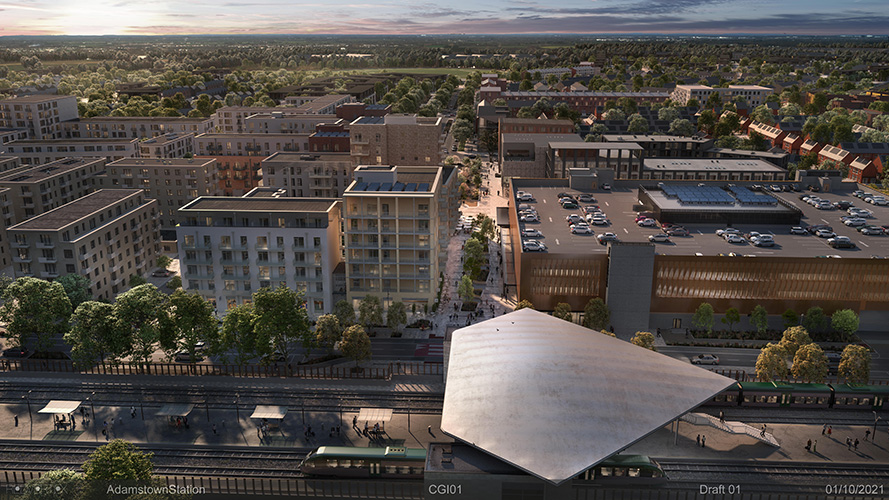
Quintain Ireland outlook
Michael Hynes concludes by saying that of the 8,500 units Quintain currently has planned across its four sites, 1,000 are on site. Of the 7,500 units left, it has planning for 6,000 units.
“We have a robust short-term pipeline and landbanks for the next three to five years. Our goal is to output 1,500 units a year by 2027 and continue to be one of the larger developers in Ireland.
“A vital issue for us to address is acquiring our beyond-five- or 10-year landbanks. Land acquisition has been slow over the past few years because of the lack of good land getting to the market, primarily because of Covid and the war in Ukraine. People weren’t under debt pressure, so they didn’t have to sell.
“But now, with the vacant site levy and land taxes about come in, this has prompted non-natural landholders – be that religious orders, families or organisations – to deal with this issue. Otherwise, the assets they are sitting on will devalue through taxation.
“We see opportunities to acquire prime land we didn’t have over the past few years. That said, we want to find the right land acquisition opportunities to ensure we maintain our quality landbanks. We like to have between 8,000 to 10,000 units at various stages of short-, medium- and long-term development.
“Outside of that, I don’t think the PRS market will return to scale until after next year. When interest rates settle, the investor market will start to function as much as the social, affordable and cost-rental market is moving now. But we can’t and should not be relying on the government for the long term.
“Our ambition at Quintain is to keep our landbanks at a level that will enable us to construct 1,500 units per annum and maintain the best-in-class people that we have to deliver quality suburbs like The Crossings in Adamstown,” Michael Hynes concludes.





